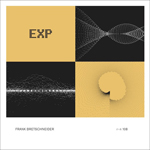|
|
 |
Dusted Reviews
Artist: Frank Bretschneider Album: Exp Label: Raster-Noton Review date: Jun. 10, 2010 |

|
|
|
 |
For better or worse, Raster-Noton is the most consistent label operating in electronic music today. Dance music labels necessarily need to change with the times, even incrementally, in order to stay relevant, and most of Raster’s experimental peers have branched out. Hell, even Erstwhile put out two albums in a series called “ErstPop.” After a decade-plus, the only tweaks in the label’s sound that I’ve heard have been slight introductions of melody from Hervé Beghossian and Kangding Ray, some woollier noise excursions under its Unum banner, and ambient one-offs from Richard Chartier and William Basinski. Even chameleon Uwe Schmidt’s Raster album mostly stuck to the label’s austere aesthetic.
The visual work of the artists, on the other hand, isn’t so easily predicted. The visuals accompanying the Raster live sets are conceptually akin to the repetitive digital overload of the music, but they attack that concept from multiple angles. Byetone comments on the determined functionality of techno by simply displaying numbers, surrounded by rhythmic white light, that count the beats of his tracks; from what I recall, the numbers reach about 1,500 or so, then simply stop when the performance ends. Alva Noto uses spastic color bar test patterns to accompany his Unitxt explorations of daily life, while Pomassl projects abstract sketches that only occasionally form geometric shapes and correspond to the rhythms. The approach changes from artist to artist and from project to project, but the point is that, especially compared to the audio, the visual side is as close as the label gets to “anything goes.”
When I saw Frank Bretschneider perform tracks from Rhythm, his most accessible and near-danceable album, I was taken aback by the relatively restrained visual work. While it matched the force of the rhythm, the actual design seemed more in the spirit of his glitchier Komet project or his collaborations with Taylor Deupree or Ralph Steinbruchel, especially when compared to the visual brashness of Byetone and Noto. If these were the visuals that Bretschneider chose to match with his most aggressive music, what did that say about how Bretschneider, a co-founder of Raster-Noton, actually views the music and the mission of his label?
Exp explains a lot about Bretschneider’s overall vision. The release is a CD + Data CD comprised of 35 brief tracks, most of them ending before the 2 minute mark, with visuals that match up to the first 18 minutes of the album. The album makes for a disjointed listening experience, with Bretschneider’s tracks bouncing from numbing repetition to sped-up rhythmic skitterings, to abstract noise, to some of his most sublime electronic funk. Hearing all of the components of the Raster sound in such quick succession might have caused me to rethink my theory about the label lacking stylistic breadth, but the visual work elides the differences. While hearing different rhythms and frequencies, the viewer sees only a single, undulating representation: sounds composed of magnetism, radiation, and waveforms of light, arranged in different patterns, all similarly controlling a sparse, uniform visual scheme.
By fully wedding the audio and visual work,Exp makes another strong argument for R-N’s monolithic power. Of course the Rhythm visuals wouldn’t vastly diverge. Alva Noto and Byetone might be a bit freer with their visual interpretations, but Bretschneider makes clear the ultimate M.O.: while other labels try to widen their palettes, with some achieving success by expertly drawing connections, Raster-Noton assimilates.
By Brad LaBonte
|







